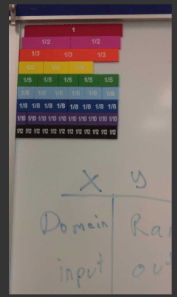This blog post originally appeared on the blog Math-World Liaison on November 11, 2017.
I am now 3-1/2 months into the 2017-18 school year and I can finally say I am seeing significant results from the move toward Common Core State Standards for math (CCSS-M) in my Algebra I students. Although Missouri voted out CCSS, the math standards were mostly preserved, but we have been relatively slow in implementing them.
Improved Procedural Skills
My Algebra I students, in general, have always arrived in my classroom with very weak understanding of fraction operations, having memorized (and confused) many tricks to solve problems on math tests. This year I hoped to see stronger skills, knowing my district has been working hard to improve and align instruction to Missouri math standards. After verifying with the lower grade teachers that they were using fraction sticks, I bought a set of magnets.
 When a fraction appears in a problem I am discussing with my students, I can slide down a few sticks, and the understanding rapidly clicks into place. In prior years, my students would say, “KFC!” (Keep-Flip-Change!) and flip their fractions in contexts where that trick doesn’t work. No one has mentioned chicken this year, Kentucky Fried or otherwise.
When a fraction appears in a problem I am discussing with my students, I can slide down a few sticks, and the understanding rapidly clicks into place. In prior years, my students would say, “KFC!” (Keep-Flip-Change!) and flip their fractions in contexts where that trick doesn’t work. No one has mentioned chicken this year, Kentucky Fried or otherwise.
In 2014-2015, NCTM published 13 Rules that Expire and 12 Math Rules that Expire in the Middle Grades. Around the same time, Tina Cordone released Nixthetricks.com which has been downloaded around 50,000 times from Amazon. No doubt these publications have run the math-ed circuit, adding much support to the CCSS-M mission of balancing procedure, concept (understanding, connection, big picture), and application. Fraction sense is one of the results I had hoped for when I first read the draft. It is exhilarating to witness the improvement in my own classroom, but there are other effects I find equally exciting.
More Interesting and Informative Instruction
Many of the CCSS seem to inspire student-centered instructional methods. With fewer standards, there is more time to go in depth. Standards that require student explanations are perfect for whole-class discussions, Kagan & McREL strategies, and innumerable others that engage and challenge students in ways that traditional direct or repetitious instruction cannot. After trying some of those methods and seeing improved retention, I volunteered to pilot an inquiry-based e-book with my students this year. Inquiry-based learning requires a major shift in teaching strategies from telling to coaching. The effect on my students and classroom environment has been transformational, building ambition, retention, empathy, and 21st-century career skills. When students finish early, they are allowed to work ahead with Khan or on particular skills I assign to individual students as I detect weaknesses in their work. They find joy as they notice themselves growing. Today’s between-class art looked like this on my whiteboard:
Needless to say, not one student has asked me this year if they would ever use this stuff in real life.
It is often difficult for high school teachers to envision inquiry-based learning in a math classroom, not just because it is so different, but because of sincerely held beliefs about what students need to learn going into college. A recent question posed on NCTM’s discussion board, for example, asked about why we need to teach Descartes’ Rule of Signs. I surmised that the teacher posing the question did not realize the CCSS omit Descartes and other extraneous, tedious topics to make room for deep explorations into modeling problems. It is extremely helpful to have high-quality instructional materials that align well with the CCSS to be able to emphasize truly important concepts. In another post, Chief CCSS writer Dr. William McCallum helped me compile a list of topics that would best be abandoned in Algebra 2. The list is linked near the end of the blog post and can also be found here.
Just as there has been opposition to CCSS, there is opposition to inquiry-based learning. There are some good reasons to be cautious. However, when inquiry instruction is done well, I believe it is the key to meeting the needs of today’s students. Like CCSS, it will probably take many years before the benefits become well understood. In my thinking, it is worth the wait.

















